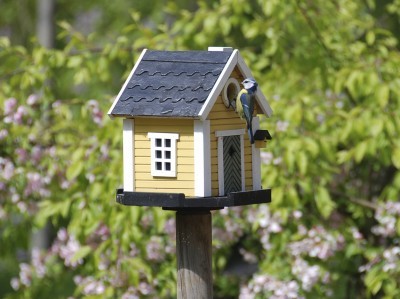






While most people give it little thought, we bird lovers know that part of attracting birds to our gardens means providing them a suitable home in addition to feeding them. So what types of birdhouses are available? Let’s find out more.
There are a number of different birdhouses to choose from. Some are easy to construct yourself and others can simply be purchased from most garden centers. You’ll find birdhouses that swing, some that are decorative, and others that are nothing more than simple nest boxes or gourds. They may be constructed of wood, metal or even plastic depending on the style. Some, such as birdhouse gourds or plastic jugs, are made from everyday household items.
If you’re an avid birdwatcher, then you already know that each bird prefers its own type of birdhouse, including specific locations and sizing of the structures. Small birds like wrens or sparrows, for example, are normally attracted to single-unit enclosures near the protective cover of shrubbery. That said, they will nest nearly anywhere they feel is suitable, including hanging plants or even an old tea kettle left outdoors (as has happened in my garden many times).
Other birds might prefer larger houses in open areas of the garden or those that hang among the cover of trees. It’s best to research the individual preferences of common bird species in your area, though adding a variety of bird nesting structures throughout the landscape will attract any numbers of birds, as they will seek out and move into whichever shelter they feel most comfortable with.
Unless your objective is from a decorative standpoint, then any birdhouse structure you intend to use in the garden will need to remain simple. In other words, stay away from lots of paint and other embellishments. The birds don’t really care about all that anyway.
The best type of birdhouse will offer sanctuary for birds and a safe place to raise and feed their young. Those that are placed up high, as well as having baffles or guards, will provide additional protection from predators. Additionally, locating the birdhouse nearby a branch or other suitable perch will allow adult birds to keep watch over their homes and their babies. Your birdhouse will need to offer protection from bad weather too.
Drainage is another factor when using birdhouses in the garden. Water that gets in as a result of wind and rain needs to drain out quickly so the little birds don’t become saturated or drown. Likewise, suitable ventilation is a must so the birds don’t becomes too hot in the heat of summer. Placing garden birdhouses away from winds and near trees or other structures will help with both water and ventilation issues.
Most birdhouse information says that late winter to early spring is the most ideal time for putting a birdhouse for gardens in place. Birds will normally be migrating back to the area and looking for shelter to raise their broods. Once you’ve chosen and positioned the home, offer some loose nesting materials for them. I like to place these in a suet feeder hung nearby. Materials should be less than 6 inches in length and may consist of anything from pieces of yarn or fabric to short sticks and hair collected from brushes.
It’s also important that the birdhouses be cleaned annually. This can be done during the off season when its occupants have migrated to warmer locations. Hosing them down and washing with bleach will help disinfect the birdhouses and minimize the spread of possible disease. Don’t forget to dispose of any leftover nesting materials.
Garden Care Tips For Different Types Of Gardens
Tips For Lighting And Watering Your Greenhouse
Tips And Tricks For A Great Organic Garden
Tips For Having A Bountiful And Productive Garden
Technology and Garden Gadgets – Tips On Using Technology In Landscape Design
Cheesecloth Fabric: Tips For Using Cheesecloth In The Garden
Colonial Garden Plants: Tips For Growing And Designing Colonial Period Gardens
Copyright © www.100flowers.win Botanic Garden All Rights Reserved